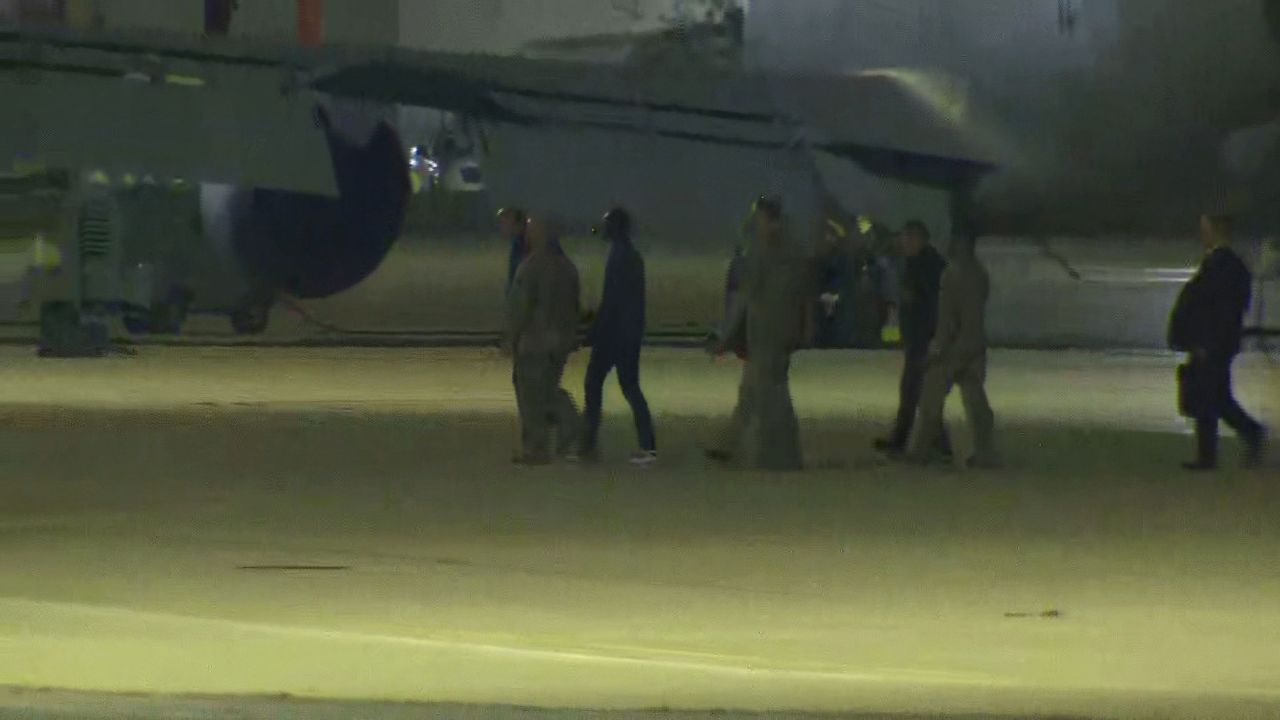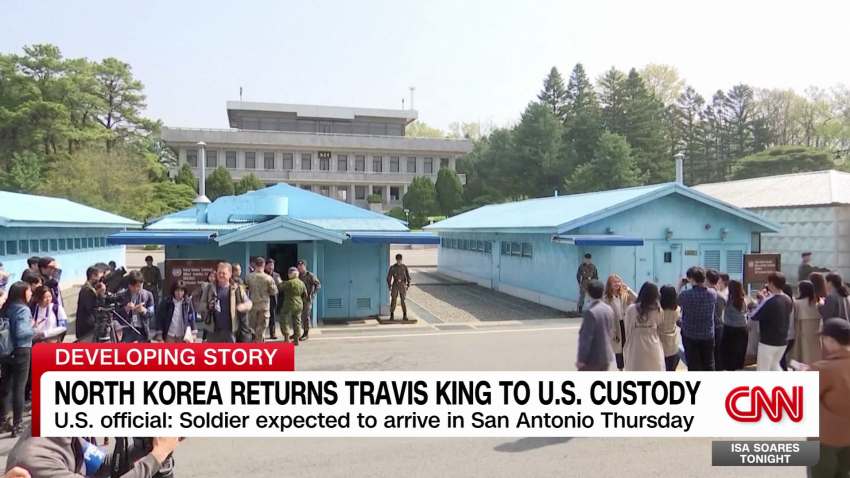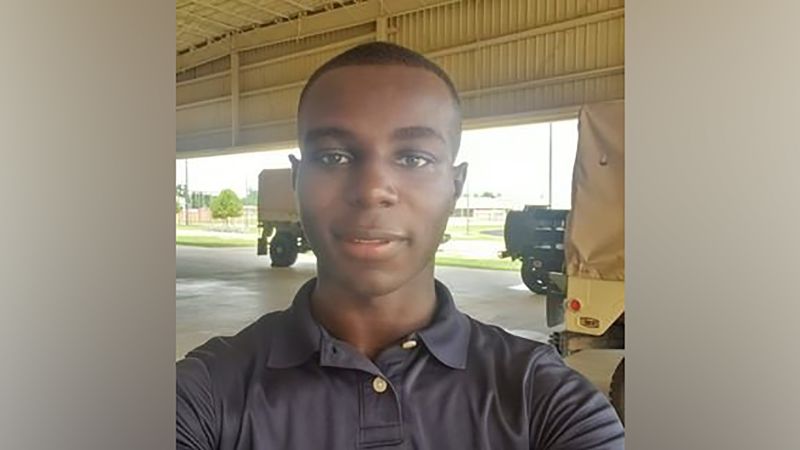CNN
—
US Army Private Travis King arrived back on United States soil Thursday after being returned to American custody weeks after he crossed into North Korea, a Defense Department official said.
King flew in on a US military flight, landing at Kelly Field at Joint Base San Antonio-Fort Sam Houston around 1:30 a.m. ET, the official said.
A CNN camera captured what appears to be King being escorted off the plane by several people. They met officials waiting on the ground and led King off to another area of the military base, out of sight of the camera.
While many questions still remain, such as what prompted King to enter North Korea and whether he will face any disciplinary action, his return marks a rare diplomatic success between Washington and Pyongyang at a time of fraught relations.
It also caps a frenetic period of negotiations to secure King’s release, with weeks of what US officials called “intense diplomacy” between multiple countries including China, which facilitated King’s transfer across the border on Wednesday, and Sweden, which acts as the US protecting power in North Korea.

North Korean state media KCNA had reported Wednesday that Pyongyang had decided “to expel” King, who entered their territory in July during a tour of the Joint Security Area (JSA) in the heart of the demilitarized zone between the two Koreas.
Two US officials told CNN Wednesday that King is expected to be taken to Brooke Army Medical Center in San Antonio upon his return, which has a dedicated program to help Americans acclimate back to normal life after being detained.
US military officials have said that King, a junior enlisted cavalry scout, “willfully and without authorization” crossed into North Korea in July.
King had been released from a detention facility in South Korea just over a week before running across the demarcation line – punishment which appeared to stem from an October 2022 incident in which he allegedly pushed and punched a victim in the face at a club in Seoul, according to court documents.
The day before he crossed into North Korea, King was supposed to board a flight to Texas, where he was to face disciplinary procedures.
But after Army escorts released him at a security checkpoint at Incheon International Airport near Seoul, King left the airport on his own.
The next day, he joined a tour of the JSA he had previously booked with a private company.
There is no physical barrier inside the JSA, and a US official previously said that after bolting over the demarcation line delineating the border, King tried to enter a North Korean facility – but the door was locked. He then ran to the back of the building, at which point he was hurried into a van and driven away by North Korean guards.
Pyongyang claimed Wednesday that King had “confessed that he illegally intruded into the territory of the DPRK (North Korea) as he harbored ill feeling against inhuman maltreatment and racial discrimination within the US army and was disillusioned about the unequal US society.”
CNN cannot verify whether those are King’s own words. But pressed on Wednesday whether King wanted to return, a US official said it became “quite clear” to US diplomats that “Private King was very happy to be on his way home.” The official added that King was in “good health and good spirits” as he made his way home.
The North Koreans on Wednesday handed King off to the US Ambassador to China Nicholas Burns in Dandong, China.
A Swedish convoy took King to the Friendship bridge on the border between North Korea and China, two US officials told CNN on Wednesday. On the Chinese side of the bridge, the US Defense Attache to China Brigadier General Patrick Teague and Burns met King and took him into US military custody.
State Department Spokesperson Matthew Miller said that King then flew to Shenyang, China, and then to Osan Air Force Base in South Korea before departing for the US.
The US received word earlier this month from Sweden that Pyongyang wanted to release King.
And according to a US official, China’s role was limited to helping facilitate King’s transfer out of North Korea, but otherwise Bejing did not play a “mediating role.”
China’s foreign ministry briefly touched on King’s transfer at a regular briefing.
“At the request of North Korea and the US, China provided necessary assistance from a humanitarian point of view,” spokesperson Mao Ning told reporters.
US officials have emphatically said the US did not make any concessions to North Korea for the transfer.

North Korea returns Travis King to U.S. custody
King is believed to be the first US soldier to cross into North Korea since 1982. The JSA, which he’d been touring, lies along the demilitarized zone (DMZ) that has separated North and South Korea for decades – often described as one of the world’s most armed borders.
While a handful of US soldiers defected to North Korea in the decades after the end of the Korean War, the most recent instances of US nationals being detained in the country have been civilians – sometimes for long periods as US officials try to secure their release and Pyongyang looks to extract concessions.
One of the most well-known recent cases was that of Otto Warmbier, an American college student who traveled to North Korea as a tourist in 2016. After being held in detention for 17 months, he was released to US officials in 2017 and died with severe brain damage less than a week after his return, with Washington saying he had been tortured in custody.
King’s crossing came at a time of particularly high tension between North Korea and the US and its allies.
Pyongyang regards the US as a mortal enemy, and the two have no diplomatic relations – which is why Sweden is appointed as the US’ protecting power in North Korea, providing consular protection to American nationals there and representing the US in diplomatic matters.
North Korea’s nuclear force has long been a sticking point, with the US and South Korea urging Pyongyang for decades to give up its nuclear weapons. Threats escalated in 2017, when North Korea launched its sixth and most recent nuclear test – but cooled off in 2018 when North Korean leader Kim Jong Un held a series of talks with then-US President Donald Trump.
However, the talks ultimately fell through with no deal delivered.
North Korea ramped up its weapons testing in 2022, firing a record number of missiles, which has continued this year. In response, the US, South Korea and Japan have drawn closer together, vowing greater cooperation and planning new military drills – to Pyongyang’s anger.
Earlier this month, US officials publicly warned that Pyongyang could provide weapons to Russia for its faltering invasion of Ukraine, with Kim traveling to Russia for a six-day visit during which he met with Russian President Vladimir Putin.
In return, experts warned, Pyongyang could receive help with its own nuclear weapons and missile program.
